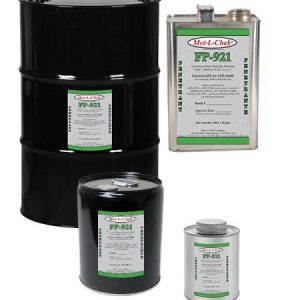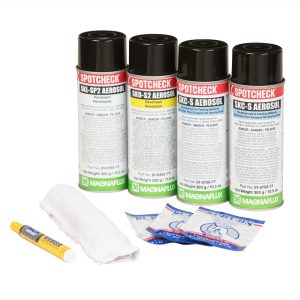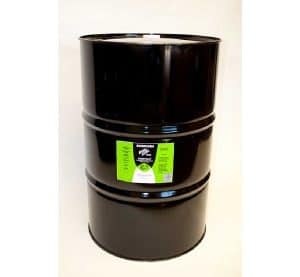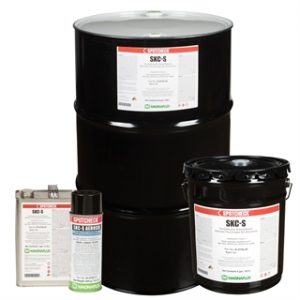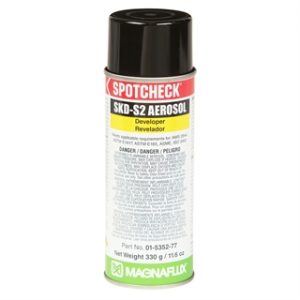- Effective in removing oily soils, light grease, finger prints, cutting fluids and coolants, salt residues, loose scale and rust.
- Safe for use on steel, aluminum, magnesium, copper, titanium, nickel alloys; most plastics, composites and bonded paints.
- Nonflammable, phenol free, heavy metals free, low foaming, and utilizes biodegradable surfactants.
- Used in soak tanks, agitated dip tanks, spray washers, steam cleaners, and ultrasonic cleaners.
- Low foaming, free rinsing, yielding clean streak free surfaces.
-
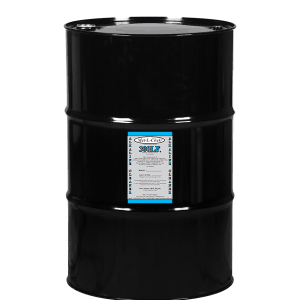 Features and Benefits:
Features and Benefits: -
 DR-60 Cleaner-Remover is used in the penetrant process to remove excess, nonwater-washable penetrants from part surfaces, e.g., Sherwin DP-40 Dye Penetrant (visible red) and Sherwin RC-65 and RC-77 Flourescent Penetrants. It is a manual “wipe on” and “wipe off” material and, consequently, recommended for small areas.
DR-60 Cleaner-Remover is used in the penetrant process to remove excess, nonwater-washable penetrants from part surfaces, e.g., Sherwin DP-40 Dye Penetrant (visible red) and Sherwin RC-65 and RC-77 Flourescent Penetrants. It is a manual “wipe on” and “wipe off” material and, consequently, recommended for small areas. -
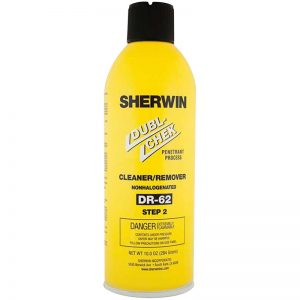 DR-62 Cleaner-Remover is used in the penetrant process to remove excess, non water-washable penetrants from part surfaces, e.g., Sherwin DP-40 Dye Penetrant (visible red) and Sherwin RC-65 and RC-77 Fluorescent Penetrants. It is a manual “wipe on” and “wipe off” material and, consequently, recommended for small areas.
DR-62 Cleaner-Remover is used in the penetrant process to remove excess, non water-washable penetrants from part surfaces, e.g., Sherwin DP-40 Dye Penetrant (visible red) and Sherwin RC-65 and RC-77 Fluorescent Penetrants. It is a manual “wipe on” and “wipe off” material and, consequently, recommended for small areas. -
 E-50 emulsifier is ideal for use on rough castings and other metal surfaces which tend to retain penetrant readily, which causes high background and difficulty in evaluating indications.It is effective in rendering most light oily soils water washable and has been used as a pre-wash cleaner for tough to clean surfaces. It has found use as a concrete cleaner for the removal of oily residues. The emulsifier is applied, allowed to soak in for a few minutes , and then washed off with water spray.
E-50 emulsifier is ideal for use on rough castings and other metal surfaces which tend to retain penetrant readily, which causes high background and difficulty in evaluating indications.It is effective in rendering most light oily soils water washable and has been used as a pre-wash cleaner for tough to clean surfaces. It has found use as a concrete cleaner for the removal of oily residues. The emulsifier is applied, allowed to soak in for a few minutes , and then washed off with water spray. -
 For immersion the use range is 17 – 20 % or 1 part emulsifier to 4 parts water. The concentration is controlled by using a brix refractometer and a concentration chart. For spray applications the concentration is kept below 5 %. In immersion applications the penetrant covered part is given a quick water wash and then immersed into the gently agitated emulsifier from 30 seconds to 2 minutes depending upon the part surface roughness. The part is removed and washed. The pre-rinse step may be omitted for the spray application method of the emulsifier.
For immersion the use range is 17 – 20 % or 1 part emulsifier to 4 parts water. The concentration is controlled by using a brix refractometer and a concentration chart. For spray applications the concentration is kept below 5 %. In immersion applications the penetrant covered part is given a quick water wash and then immersed into the gently agitated emulsifier from 30 seconds to 2 minutes depending upon the part surface roughness. The part is removed and washed. The pre-rinse step may be omitted for the spray application method of the emulsifier. -

- It is a slow dry rate material and is ideal for penetrant wipe removal and is not used as a pre-inspection surface cleaner. As a penetrant remover it is sprayed onto wiping media and then the penetrant wiped from the surface.
- The remover should not be sprayed directly on to the test surface to remove the excess penetrant as the sensitivity will be impaired.
- Contains combustible solvents and should not be used around open flames or sparks.
Available as 1 pint (0.5 L), 1 gallon (3.8 L), 5 gallon (18.9 L), 55 gallon (208 L)
-

- As a pre-cleaner it is sprayed directly on the test surface.
- As a penetrant remover it is sprayed onto wiping media and then the penetrant wiped from the surface.
- The remover should not be sprayed directly on to the test surface to remove the excess penetrant as the sensitivity will be impaired.
- Contains flammable solvents and should not be used in confined spaces or near open flames or sparks.
Available as 1 pint (0.5 L), 1 gallon (3.8 L), 5 gallon (18.9 L), 55 gallon (208 L)
-
 R-502 finds wide use in field weld and weld repair inspection. It is used in the inspection of refinery processing equipment that is at elevated temperatures, speeding up the inspection process time by eliminating the cool down required for standard penetrant processing. Protective gloves should be worn while working on hot surfaces to avoid burns.
R-502 finds wide use in field weld and weld repair inspection. It is used in the inspection of refinery processing equipment that is at elevated temperatures, speeding up the inspection process time by eliminating the cool down required for standard penetrant processing. Protective gloves should be worn while working on hot surfaces to avoid burns.Available as 1 pint (0.5 L), 1 gallon (3.8 L), 5 gallon (18.9 L)
-

- As a pre-cleaner it is sprayed directly on the test surface.
- As a penetrant remover it is sprayed onto wiping media and then the penetrant wiped from the surface.
- The remover should not be sprayed directly on to the test surface to remove the excess penetrant as the sensitivity will be impaired.
- Contains flammable solvents and should not be used in confined spaces or near open flames or sparks.
-
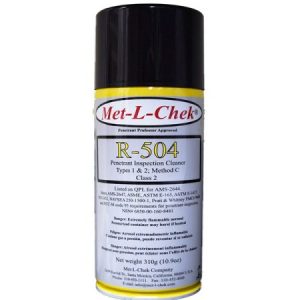
- As a pre-cleaner it is sprayed directly on the test surface.
- As a penetrant remover it is sprayed onto wiping media and then the penetrant wiped from the surface. The remover should not be sprayed directly on to the test surface to remove the excess penetrant as the sensitivity will be impaired.
- A cotton swab is moistened with R-504 and suspected indications are lightly wiped from the surface. The inspector can evaluate the indication by the rate of penetrant bleed back. The rapid drying of R-504 is ideal for this application as it does not blur the indication.
- The aerosol comes with a spray tube that facilitates pin point application which is ideal for cleaning the star indications on TAM panels.
- Contains flammable solvents and should not be used in confined spaces or near open flames or sparks.
Available as 1 pint (0.5 L), 1 gallon (3.8 L), 5 gallon (18.9 L), 55 gallon (208 L)









